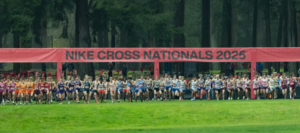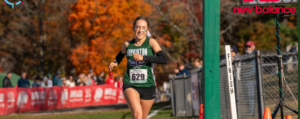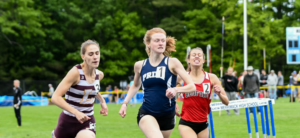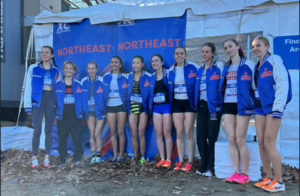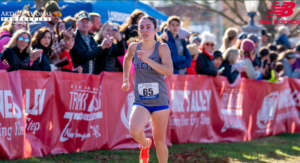As I’ve written I’ve said I have made a lot of friends through this sport. Having been around a while and hanging with other coaches who have been around a while, a question came up recently is how many truly classic courses still exist out there. There was a suggestion, made in my company, someone should write about those classic courses which still remain, and I can only assume they tossed out that crumb hoping I would put pen to ink. So here we go.

Jogging my memory I tried to remember back to the original course at my alma mater Mascenic. While there had been a cross country team before I joined, it had gone defunct and no one remembered where the original course was, or even if there was a home course. My coach at the time established a new one, probably around 1981 or so, which had more pavement than “country” and thankfully did not exist when I took back the reins in 1999.
The next original course we had I constructed out of a couple loops we had on campus would meet the criteria of classic if I hadn’t abandoned it probably in the early 2000s. The course was three loops, utterly confusing and not conducive to racing. They overlapped and it meant the faster runners would have to criss-cross with slower runners making managing the race difficult and often leading to slower runners swearing they had completed the full circuit even though we had witnessed them joining the lead group at the end of their second loop.
So I developed a slightly different variation, two compressed loops which were fairly runnable but still had some confusing overlapping portions and one particular section I was always afraid someone would turn an ankle. It was fairly rooty and had some quick turns and undulating terrain. I was very happy when I heard that we were going to expand the campus to include an elementary school, opening up the option for a better cross country course.

And it did. Along with the new school, once you circled the periphery you had covered 1.5 miles, making for an easy two lap cross country course which eventually started and finished on the baseball field. I liked that it wasn’t entirely flat, but still allowed for people to run fast. Again, personally I think it’s one of the best and most true cross country courses in the state though it lacks the capacity for hosting more than 150 athletes at a time. Established in 2012, it’s halfway to becoming a classic.
The term “classic”, as it pertains to cars is one that is more than twenty years old, so I guess I’ll use that as a guideline for the rest of this article, and presumably, the next one I write when people around the state email me with the rest of the “oldies” I’ve missed. Having coached as long as it takes to become a classic, you’d think I’d know all the truly classic courses, but of course with three different divisions and having been located in the south of the state, there are some nooks and crannies I have not visited. So let’s get on with this first one and we’ll see about the second one.

I’m going to start with Derryfield Park, but with a great big caveat. Some people might think this is the oldest course in the state, and some could make a pretty good case for it. The Derryfield Park course has been used for a really long time, heck I remember running on a version of it back in the early 80’s. But that was a version of it, not the same course. If I recall correctly the reservoir at the top of the hill was much smaller, we ran all the way down the road, did an extra loop in the main part of the park and finished by passing where the tennis courts are now and then straight into the finish. There is a chance I’m not 100% correct as my mind becomes more porous, but I know for a fact the version being run now (new in 2024 and adjusted to a full 5K) is not the version I ran as a high schooler.
So what courses have stood the test of time?

Let’s start with Sanborn. While my teams have run on about five different versions of cross country courses at Sanborn, the course used for the Jamie Martin Invitational, which starts and finishes at the gazebo on the common, from my understanding has stayed the same, except changes in footing, for more than 25 years. My friend Scott Clark remembers setting the course record there in the 80’s that was only broken last year by ConVal’s Will Simard.
From a coaching perspective I like the Sanborn course, being able to catch my team as they move off the green and into Kingston State Park, then short cut my way to the fence which serves as the de facto 1 mile mark and then the approximate 2 mile mark before skedaddling back to the green to see the crew headed towards the finish. It’s certainly flat, usually blazing hot, and certainly steeped in history, with the namesake of the race providing the jellies for the winners for a lot of the race’s time.

Another course that has stood the test of time is the Belmont HS course, and the good question might be why. At 5142 meters, with long grinding hill you hit twice on this two loop course, my kids always had a love-hate relationship with it. We used to run it twice a season, once earlier in the year, and then around Columbus day a month later. I could use it as a barometer for the kids to show how much they improved in that time frame.
I also liked that the course was tough, the last bit of the hill kicking steeply up and truly ruining any momentum, forcing kids to get out of their comfort zone and really dig into the race. No falling asleep here. We’d gear up for the race, usually seeing a lot of our D3 competition and some D2 competition as well.
While the course hasn’t changed there was a year the traditional start and finish had to be moved, as they were having work done on the track. With the start on the upper fields and the finish in the baseball field, the time was ripe for things to get mixed up. In the girls race, the leader and the runner up missed a usual turn simply following the fence at the ballfield and potentially cutting off a few meters, however not altering the finishing places. In the boys meet, an eager freshman chose to run the wrong direction on the right path, doing a section backward and dragging the entire field the wrong way, with my guys looking quizzically at me when I could offer no counsel to what was going on. I guess that’s what happens when you mess with a good thing.

The course also doubled as the Capital Area meet course for quite some time, with the likes of Concord’s Guor Majak, a two time Olympian running ridiculously fast there back in the day. I’ve often wondered why the course hasn’t been altered as well, with what I would consider an easy fix. The race starts in the soccer field inside the track, racers aligned along the soccer end line and head off towards the start of the 100 meters on the track, where they circle the track in reverse direction before heading out the gate by the start/finish line and out onto the two loop wooded course. It always seemed strange to me that they didn’t start at the other end line down by the 100 meter start, run kittycorner towards the start of the 300 hurdles and onto the track there, making up those pesky 142 meters in the meantime. I do remember calculating the differential on what the kids would have run had it been an actual 5K on a hard course.
Now rumor has it that both Pinkerton and Kennett have courses that meet the classic criteria, at least 20 years old and haven’t been changed. I’ve never run either of those courses but I understand that Pinkerton’s is not a true 5K. If someone wants to chime in on either of these courses to clarify, send me an email and I can cover this in the next article. However I think it’s worth stating, and anyone who was around before the start of this century and ran cross country, course lengths weren’t often very standardized. Schools would figure out what they could fit in the space they had available and go with what they had. I seem to remember anything between 2.5 and 3.3 miles being pretty normal, the emphasis on the racing, not the distance and those specific times.
I’d love to hear about other “classic” courses I haven’t recognized, so if you have any that stand the test of time, send them my way and we’ll highlight them.







